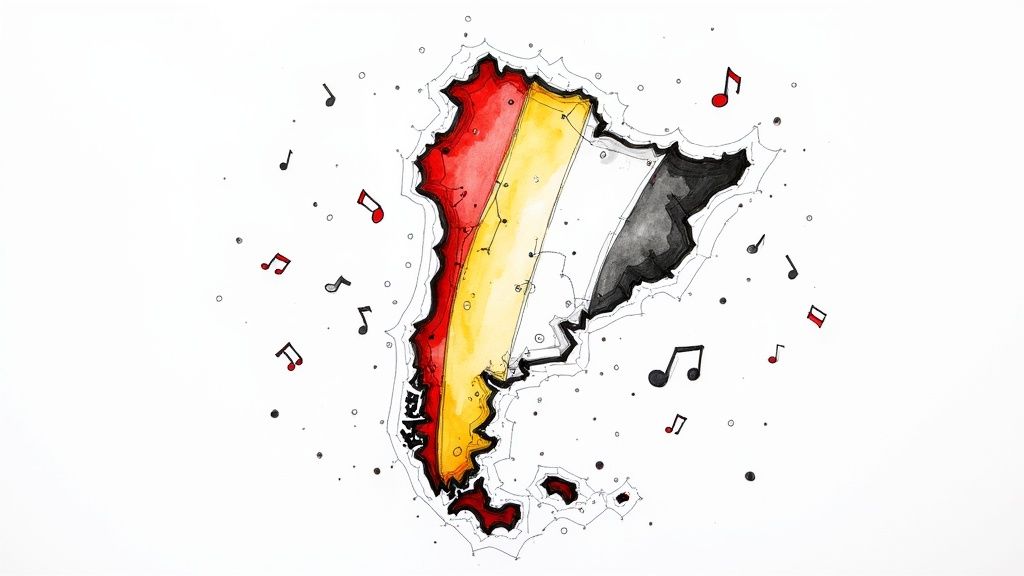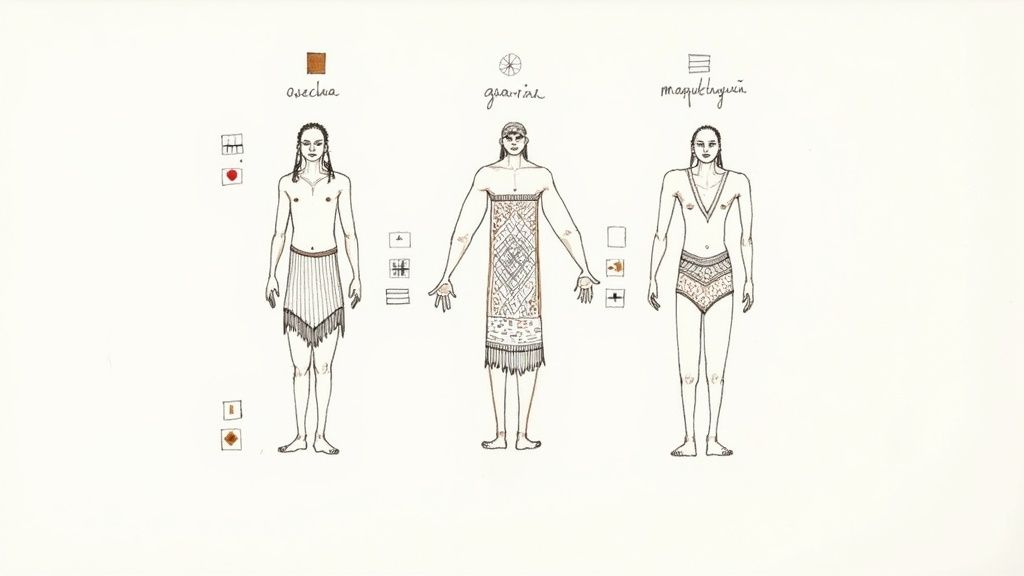A Guide to the Language in Argentina
If you've ever listened to someone from Argentina speak, you might have done a double-take. Is that Spanish? It sounds so different from what you'd hear in Spain or Mexico. You're not wrong – and the reason for that distinctive, melodic sound is a fascinating story rooted in the country's history.
Argentinian Spanish, often called Castellano, is a beautiful mix of classic Spanish vocabulary and a distinctly Italian rhythm. It's a direct result of a massive historical chapter that shaped the nation's culture and its tongue.
Why Argentine Spanish Sounds So Unique
The moment you land in Buenos Aires, you'll notice the Spanish flows with a unique cadence, an almost musical lilt. This isn't just a slight regional accent; it's a profound linguistic shift shaped by huge waves of Italian immigration in the late 19th and early 20th centuries. Millions of Italians settled in Argentina, and as they integrated, their language melted into the local Spanish.
This fusion gave rise to Rioplatense Spanish, the dialect spoken around the Río de la Plata basin. It’s the sound of the country's history in every conversation—a tale of European heritage finding a new home and a new voice in South America. Think of it as a duet: Spanish provided the words and grammar, while Italian brought the melody and a whole lot of passion.
The Foundation of a Distinct Dialect
Argentina is home to about 46.6 million people, and while over 95% speak Spanish, it's the flavour of their Spanish that sets them apart. Rioplatense Spanish is the dominant dialect, spoken by an estimated 70% of Argentinians. This makes Argentina the fourth-largest Spanish-speaking country in the world, yet its sound is unmistakable.
Perhaps its most famous calling card is the pronunciation of "ll" and "y." In most Spanish dialects, they sound like the 'y' in "yes." In Argentina, they take on a soft 'sh' sound, giving words a smooth, almost whispery quality. Curious about the finer details? Ethnologue's country report offers a deep dive into the nation's linguistic landscape.
To really get to grips with Argentinian Spanish, we're going to break down its core elements:
- The key pronunciation quirks that define the accent.
- The all-important grammar shift from 'tú' to 'vos'.
- The vibrant slang that colours everyday conversations.
More Than Just an Accent
Learning to understand Argentinian Spanish is about appreciating more than just sounds. It's about tuning into a cultural identity forged from a one-of-a-kind blend of influences. The way people talk reflects their history, their social fabric, and a deep sense of national pride. It's a dialect that’s expressive, warm, and full of character—just like Argentina itself.
If you're fascinated by how dialects diverge, a specialised tool that explores dialectal variations can give you a real sense of these linguistic shifts.
The use of 'vos' instead of 'tú' for the informal 'you' is one of the most significant grammatical markers of Argentinian Spanish. It's not just a slang term but a fully conjugated and grammatically correct form that is standard across the country.
This guide will walk you through these key concepts, helping you understand the nuances that make Argentinian Spanish so captivating. It’s a vivid reminder that the Spanish-speaking world is incredibly diverse, a topic we explore further in our guide to all the countries that speak Spanish.
Mastering the Sounds of Rioplatense Spanish
To really get a feel for the language in Argentina, you have to do more than just memorise vocabulary. You need to tune your ear to its unique music. The Rioplatense accent, especially around Buenos Aires, has a couple of defining features that make it stand out instantly from any other Spanish you've heard.
Nailing these two elements is the secret to sounding less like you're reading from a textbook and more like you're ordering a coffee like a local. These aren't just minor quirks; they’re fundamental to the rhythm and grammar of the language. The first is a distinct pronunciation called yeísmo rehilado, and the second is a grammatical cornerstone known as voseo.
Let's dive into what they are and why they're so important. Getting your head around these will completely change how you hear and speak Argentinian Spanish.
The Famous 'Sh' Sound of Argentina
Picture this: you're asking for directions to a street, or calle. In Spain or Mexico, you'd pronounce it "KA-yay." But in Buenos Aires, you'll hear "KA-sheh." That soft, hissing 'sh' sound is probably the most iconic trait of the Argentinian accent.
This is what linguists call yeísmo rehilado. It's a simple rule that has a massive impact: any word spelled with a 'y' or a double 'l' (ll) gets this 'sh' sound. It’s a small shift that completely changes the flow of speech, giving it that smooth, almost melodic quality Argentina is known for.
Here are a few classic examples that show the difference:
- Yo me llamo (My name is)
- Standard Spanish: "yo meh YA-mo"
- Argentinian Spanish: "sho meh SHA-mo"
- Pollo (Chicken)
- Standard Spanish: "PO-yo"
- Argentinian Spanish: "PO-sho"
- Playa (Beach)
- Standard Spanish: "PLA-ya"
- Argentinian Spanish: "PLA-sha"
This 'sh' sound is everywhere. You'll hear it in tango lyrics, on the news, and in everyday chats. It's the sonic signature of Argentina.
Understanding Voseo: The Use of 'Vos'
The other pillar of Argentinian Spanish is voseo. This is the widespread use of the pronoun 'vos' instead of 'tú' when you're talking to someone informally (the singular "you"). This isn't just slang; it's the standard, grammatically correct way of speaking used by millions every single day.
If you learned Spanish in a classroom, you were probably drilled on using 'tú' for friends and family. In Argentina, however, using 'tú' can sound a bit stiff, formal, or even foreign. 'Vos' is what you'll use with mates, family, and colleagues. It’s the go-to.
But 'voseo' is more than just swapping 'tú' for 'vos'. It also changes how you conjugate the verbs that follow. This is the bit that can trip learners up, but the good news is that the pattern is actually simpler and more regular than the conjugations for 'tú'.
The main change happens in the present tense. To put it simply, you take the infinitive verb, chop off the ending (-ar, -er, or -ir), and add a new, stressed ending.
Here’s a quick comparison to see how it works:
| Verb Infinitive | Standard Spanish ('tú') | Argentinian Spanish ('vos') |
|---|---|---|
| Hablar (to speak) | Tú hablas | Vos hablás |
| Comer (to eat) | Tú comes | Vos comés |
| Vivir (to live) | Tú vives | Vos vivís |
See how the emphasis in the 'vos' form jumps to that last syllable? It gives sentences a punchier rhythm, like in "¿Vos querés ir al cine?" (Do you want to go to the cinema?). If you're wondering about the learning curve, our guide on whether Spanish is easy to learn has some great tips for getting to grips with new grammar like this.
Learning to use 'vos' naturally is a huge leap toward sounding authentic. It tells people you’ve done your homework and are making a real effort to connect with the way the language is genuinely spoken in Argentina.
Getting to Grips with Argentine Slang and Expressions
If you want to sound less like a textbook and more like a local in Argentina, you have to get comfortable with its slang. We're not just talking about a few quirky words here and there; we're talking about a whole lexicon known as Lunfardo, which is the absolute soul of everyday chatter, especially in Buenos Aires.
Lunfardo wasn't cooked up in a classroom. It was born in the working-class neighbourhoods of the city, its roots deeply tangled with the passionate history of tango. Think of it as the city’s personality turned into words. Learning it is your ticket to moving beyond just speaking Spanish and actually connecting with Argentinians on their own terms.
This isn't about memorising a dictionary. It's about feeling the rhythm of the language and knowing when to drop the right word to show you get it.
The infographic below highlights a few classic slang words you'd absolutely hear wandering around a Buenos Aires neighbourhood.
As you can see, terms like "che," "bondi," and "quilombo" aren't just for show—they're woven right into the fabric of daily conversations.
Starting with the Heavy Hitters of Lunfardo
First up, the undisputed king of Argentine Spanish: che. You'll hear this everywhere. It's an all-in-one attention-grabber that can mean "hey," "mate," "dude," or "pal." It’s the glue of informal conversation.
- Chatting with a friend: “Che, ¿vamos por un café?” (Hey, fancy a coffee?)
- Getting someone's notice: “Che, se te cayó algo.” (Hey, you dropped something.)
Then there's quilombo. This one is brilliant. While it originally referred to a brothel, today it means a total mess, a disaster, or just a chaotic situation. It's incredibly versatile, used for everything from a messy desk to a full-blown political scandal.
If a friend is going through a tough time, they might sigh and say, “Mi vida es un quilombo ahora.” (My life is a complete disaster right now.) It’s a word that packs a punch, perfectly capturing that feeling of chaos.
Essential Slang for Everyday Chats
Once you're comfortable with "che" and "quilombo," you can start sprinkling in other common terms. These are the words that will make you sound less like a visitor and more like someone who’s really tuned in.
For example, nobody says autobús. It’s always the bondi. So, you'd say, “Tengo que tomar el bondi para ir al centro.” (I have to catch the bus to get downtown.)
Here are a few more must-knows:
- Pibe/Piba: This is how you say boy or girl, kind of like "kid" or "guy/gal." It's used all the time, often affectionately.
- Fiaca: This is a fantastic word that describes that specific feeling of laziness or just not being bothered to do anything. "Tengo fiaca, no quiero hacer nada hoy." (I feel so lazy, I don't want to do anything today.)
- Mango: This means money, specifically one Argentine peso. If something's a bargain, you might say it only costs a few mangos.
Pro-Tip: Using slang isn't just about the words themselves; it's about the attitude. It adds a layer of warmth and personality to your Spanish, making your conversations feel far more authentic.
To help you get the hang of it, here’s a quick-reference table with some more classic Lunfardo terms.
Common Argentine Slang and Their Meanings
| Slang Term | What It Means | Example of Use |
|---|---|---|
| Laburo | Work, job | “Tuve un día terrible en el laburo.” (I had a terrible day at work.) |
| Birra | Beer | “¿Vamos a tomar una birra después?” (Shall we go for a beer later?) |
| Mina | Woman, girl (can be slightly objectifying depending on context) | “Esa mina de allá es la hermana de Juan.” (That girl over there is Juan's sister.) |
| Chabón/Chabona | Guy/Dude, Girl/Chick | “Ese chabón es muy buena onda.” (That guy is really cool.) |
| Posta | For real, true, seriously | “¿En serio te vas a mudar? ¡Posta!” (Are you really moving? For real!) |
Getting these words into your active vocabulary is a game-changer. They’re the little details that show you've really been listening.
Seeing It All in Action
Let's imagine a quick chat between two friends trying to make plans. This is how you'd hear these words used naturally.
Friend A: “Che, ¿qué hacés esta noche? ¿Querés ir al cine?” (Hey, what are you up to tonight? Want to hit the cinema?)
Friend B: “Uf, no sé. Tuve un día terrible en el laburo, fue un quilombo total. La verdad es que tengo mucha fiaca.” (Ugh, I don't know. I had a nightmare day at work, it was a complete mess. Honestly, I'm feeling super lazy.)
Friend A: “Dale, no seas así. La peli es buenísima. Después tomamos el bondi y vamos por una pizza.” (Come on, don't be like that. The movie is great. We can grab the bus afterwards and go for a pizza.)
Learning these phrases will do wonders for your Spanish journey in Argentina. For more tips on everyday conversation, check out our guide on the different ways to ask how someone is in Spanish.
Discovering Argentina's Indigenous Languages
While the Spanish of Buenos Aires often gets all the attention, it’s only one part of Argentina’s linguistic story. The country’s full narrative stretches back centuries before Spanish ships ever arrived, to a time when the land was alive with a diverse tapestry of indigenous languages.
These languages aren’t historical footnotes. They are living, breathing expressions of culture, still spoken today and deeply woven into the nation’s identity.
To really get a feel for Argentina, you have to look beyond the capital and listen to the voices that have echoed through the Andes, the Gran Chaco, and Patagonia for generations. It’s a powerful story of survival, cultural pride, and the fight to keep ancestral tongues alive.
The Major Indigenous Languages Still Spoken Today
Argentina is home to a surprising amount of linguistic diversity. At least 14 distinct indigenous languages are still spoken across the country, each with its own community of speakers. While some are spoken by just a handful of people, others are central to entire regional identities. Find out more about Argentina's linguistic diversity on Wikipedia.
Three of the most widespread indigenous languages you might come across are Quechua, Guaraní, and Mapudungun.
- Quechua: Spoken mainly in the northwestern provinces like Jujuy and Salta, Quechua connects modern Argentina to the ancient Inca Empire. It’s not just one language but a whole family of languages spoken by millions throughout the Andes.
- Guaraní: Head to the northeast, in provinces like Corrientes and Misiones, and you’ll find Guaraní. It's a major regional language and even has official status right next door in Paraguay, showcasing cultural ties that are far older than any modern border.
- Mapudungun: This is the language of the Mapuche people, heard in the Patagonian regions of southern Argentina and Chile. The name literally means "language of the land," which perfectly captures its deep-rooted connection to the natural world.
Why Preservation Is More Than Just Saving Words
These languages are so much more than grammar and vocabulary; they are living archives of culture, history, and unique ways of seeing the world. They hold specific knowledge about local plants, animals, and spiritual traditions—concepts that often have no direct equivalent in Spanish.
When an indigenous language vanishes, it's like an entire library of irreplaceable human knowledge burning down. That's why community-led preservation efforts are so incredibly important.
Revitalisation projects aim to pull the language out of textbooks and put it back into everyday life. This means creating bilingual schools, publishing children's books in native languages, and even using radio and social media to engage younger generations.
These initiatives aren't just about preserving words. They are about strengthening cultural identity and ensuring the rich heritage of Argentina’s first peoples has a voice for the future.
Patagonia's Welsh Twist
In a fascinating side-note to Argentina's linguistic story, a completely different language took root in Patagonia. In 1865, a determined group of about 150 Welsh settlers sailed to Chubut province. They were looking for a place where they could freely practise their culture and speak their own language, which they felt was being suppressed back in Britain.
They founded towns like Gaiman and Trevelin, creating a little slice of Wales on the windswept steppe. For a long time, Welsh was the main language spoken there, complete with traditional cultural festivals called Eisteddfodau.
Today, Spanish is dominant, of course, but the Welsh legacy is everywhere. You'll see town signs in both Welsh and Spanish, and stopping at a traditional Welsh tea house is a must-do for visitors. The language is still taught in local schools, a remarkable testament to a small community’s success in keeping its unique identity alive thousands of miles from home.
The Influence of English and Other Languages
While Argentina's identity is deeply tied to its unique Rioplatense Spanish, the country doesn't exist in a linguistic bubble. Far from it. Thanks to globalisation, a strong focus on education, and waves of historical immigration, other world languages have found their place—especially English, which plays a huge role in business, culture, and daily life.
This multicultural influence doesn't water down the local dialect. Instead, it adds another layer to how Argentinians connect with the rest of the world. It paints a picture of a country that fiercely protects its heritage while openly embracing global connections.
English Proficiency in Argentina
Take a walk through the business hubs of Buenos Aires or any popular tourist spot, and you'll hear English being spoken everywhere. Argentina actually stands out in Latin America for its relatively high English proficiency. This is no accident; it’s the direct result of an education system that has long prioritised teaching English in schools from an early age.
This emphasis has turned English into a practical lingua franca, particularly for younger, city-dwelling Argentinians. In fact, around 42.3% of the population reports speaking at least some English, giving the country the highest proficiency ranking in Central and South America. While only about 15.4% claim to have high comprehension, this solid foundation is vital for international business and tourism. For anyone curious to dive deeper, you can discover more insights about Argentina's languages on Rosetta Stone's blog.
You'll see this bilingualism most clearly in a few key areas:
- Business and Technology: The booming tech sector and international trade simply couldn't function without English.
- Tourism: From hotels and restaurants to tour guides in major cities, English is the go-to language for communicating with visitors.
- Higher Education: Many university programmes, especially at the postgraduate level, rely on English-language textbooks and academic papers.
The Lasting Echoes of European Immigration
Beyond English, you can still find traces of the great European migrations of the late 19th and early 20th centuries woven into Argentina’s linguistic fabric. While Italian had the biggest hand in shaping the Spanish dialect itself, other languages also left a lasting impression.
German, for example, is still spoken in certain communities, particularly in provinces like Córdoba and Misiones where German settlers founded towns. You'll often find these communities have their own cultural centres and schools dedicated to keeping their linguistic heritage alive.
This blend of languages paints the complete picture of Argentina. You have a dominant Spanish dialect moulded by Italian, a strong command of English for global engagement, and enduring pockets of other European and indigenous languages. It’s a nation that is both deeply local and remarkably international.
Ultimately, the languages spoken in Argentina are a living reflection of its history and its future. The country honours its European immigrant past, works to preserve its indigenous tongues, and strategically uses English to forge connections with the wider world. This adaptability makes Argentina a fascinating place for any language enthusiast, offering a rich and varied environment where many different voices can be heard.
Your Top Questions About Language in Argentina, Answered
Alright, let's dive into some of the questions that pop up most often when people talk about the Spanish spoken in Argentina. If you're a traveller, a language learner, or just plain curious, think of this as your quick guide to clearing up any confusion before you dive into the country's unique culture.
Is Argentinian Spanish a Different Language?
Not at all. Argentinian Spanish is a dialect, not a separate language. It’s the same relationship as American English has to British English. The foundation—the core grammar and most of the vocabulary—is the same. A speaker from Spain or Mexico will have no trouble understanding and communicating with an Argentinian.
That said, the differences are striking and you'll notice them right away. The pronunciation is the big one, with that distinctive ‘sh’ sound for ‘y’ and ‘ll’. Then there's the grammar, especially the use of ‘vos’ instead of ‘tú’. And of course, there’s the wonderfully rich local slang, Lunfardo. It's Spanish, but with a strong, unforgettable regional flavour.
While you’ll be understood perfectly well using standard Spanish, switching to the local ‘vos’ and throwing in a bit of slang is the quickest way to sound natural and really connect with people.
Can I Get By with English in Argentina?
Yes, you can, particularly in major cities and tourist hotspots. In Buenos Aires, you’ll find plenty of people in hotels, restaurants, and shops who speak English well, especially among the younger generation. Argentina actually has one of the highest levels of English proficiency in Latin America, so you won't usually struggle to find help.
However, sticking only to English means you'll be scratching the surface of what the country has to offer. The moment you step outside the main tourist zones or visit a smaller town, you'll find that some basic Spanish is essential. Honestly, even just making an effort with simple greetings and questions is hugely appreciated and opens the door to much more authentic experiences.
What Is the Official Language of Argentina?
The one and only official language of Argentina is Spanish. It's the language of government, schools, media, and everyday life from the top of the country to the bottom.
While there are other languages spoken, none of them hold official status nationally. This includes indigenous languages like Quechua and Guaraní, which are spoken in certain communities, as well as languages brought by immigrants, like Italian and German. These languages are a vital part of the cultural fabric in their regions, but Spanish is the undisputed language of the nation.
Is Italian Also Spoken in Argentina?
You won't hear much Italian being spoken on the streets today, but its influence is absolutely everywhere. The massive wave of Italian immigration during the late 19th and early 20th centuries didn't just shape the food and culture; it fundamentally changed the sound of Argentinian Spanish.
That musical, almost sing-song intonation you hear in the Rioplatense dialect? That’s a direct echo of Italian speech patterns. On top of that, a huge chunk of Lunfardo, the local slang, comes straight from Italian words. So, while Argentinians speak Spanish, the sound and soul of their language carry a heavy, unmistakable Italian heritage.
Should I Learn Spanish Before Visiting?
I would highly recommend it! While you can manage with English in tourist areas, knowing even a little bit of Spanish will completely transform your trip. It just makes everything smoother—ordering a coffee, asking for directions, or figuring out the bus system becomes a breeze instead of a challenge.
You don't need to be fluent. Just getting a few key phrases under your belt will make a world of difference.
- The Essentials: Hola (Hello), Buen día (Good morning), Gracias (Thank you), Por favor (Please).
- Practical Questions: ¿Cuánto cuesta? (How much does it cost?), ¿Dónde está el baño? (Where is the bathroom?).
- The Argentinian Touch: Try using ‘vos’ instead of ‘tú’. So instead of “¿Tú quieres…?”, you’d say “¿Vos querés…?”.
This small effort shows respect for the local culture, and Argentinians will really warm to you for it, making your interactions that much more rewarding.
What Is the Hardest Part About Learning Argentinian Spanish?
For most people who've studied Spanish before, the two biggest hurdles are getting the hang of the ‘vos’ conjugation and adjusting their ears to the ‘sh’ pronunciation. If you’ve spent time learning standard Spanish, your brain is hardwired for ‘tú’ and its verb endings, so consciously switching to ‘vos’ takes a bit of practice.
Likewise, that yeísmo rehilado (the ‘sh’ sound) can throw you off at first. You might not recognise words like calle (street) or lluvia (rain) because they sound so different. But after a little bit of listening, these unique traits quickly become second nature. Honestly, it's all part of the fun of learning this incredible dialect. The slang, Lunfardo, can also be tricky, but you'll start picking it up naturally just by being around locals.
At Spanish Council Singapore, we believe that understanding these cultural nuances is key to truly mastering the language. Our native teachers specialise in dialects from across the Spanish-speaking world, including Argentina, providing you with the authentic skills you need for travel, work, or cultural immersion. Whether you're a beginner or preparing for an exam, our personalised lessons can help you achieve your goals.
Discover our range of Spanish courses and start your journey with us today at https://spanish.sg.















